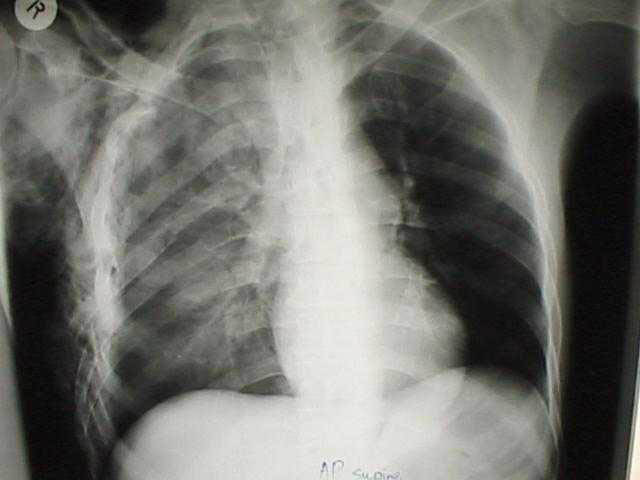Pulmonary contusion chest x ray
|
Pulmonary contusion Microchapters |
|
Diagnosis |
|---|
|
Treatment |
|
Case Studies |
|
Pulmonary contusion chest x ray On the Web |
|
American Roentgen Ray Society Images of Pulmonary contusion chest x ray |
|
Risk calculators and risk factors for Pulmonary contusion chest x ray |
Editor-In-Chief: C. Michael Gibson, M.S., M.D. [1]
Chest X Ray
 |
Chest X-ray is the most common method used for diagnosis, and may be used to confirm a diagnosis already made using clinical signs.[2] Consolidated areas appear white on an X-ray film.[3] Contusion is not typically restricted by the anatomical boundaries of the lobes or segments of the lung.[4] The X-ray appearance of pulmonary contusion is similar to that of aspiration, and the presence of hemothorax or pneumothorax may obscure the contusion on a radiograph. Signs of contusion that progress after 48 hours post-injury are likely to be actually due to aspiration, pneumonia, or ARDS.
Although chest radiography is an important part of the diagnosis, it is often not sensitive enough to detect the condition early after the injury. In a third of the cases, pulmonary contusion is not visible on the first chest radiograph performed.[5] It takes an average of six hours for the characteristic white regions to show up on a chest X-ray, and the contusion may not become apparent for 48 hours.[5] When a pulmonary contusion is apparent in an X-ray, it suggests that the trauma to the chest was severe and that a CT scan might reveal other injuries that were missed with X-ray.[6]
References
- ↑ Le Guen M, Beigelman C, Bouhemad B, Wenjïe Y, Marmion F, Rouby JJ (2007). "Chest computed tomography with multiplanar reformatted images for diagnosing traumatic bronchial rupture: A case report". Critical Care. 11 (5): R94. doi:10.1186/cc6109. PMID 17767714.
- ↑ Cohn SM (1997). "Pulmonary contusion: review of the clinical entity". J Trauma. 42 (5): 973–9. PMID 9191684. Unknown parameter
|month=ignored (help) - ↑ Fish RM (2003). "Diagnosis and treatment of blast injury". In Fish RM, Geddes LA, Babbs CF. Medical and Bioengineering Aspects of Electrical Injuries. Tucson, AZ: Lawyers & Judges Publishing. p. 55. ISBN 1-930056-08-7.
- ↑ Donnelly LF (2002). "CT of Acute pulmonary infection/trauma". In Strife JL, Lucaya J. Pediatric Chest Imaging: Chest Imaging in Infants and Children. Berlin: Springer. p. 123. ISBN 3-540-43557-3.
- ↑ 5.0 5.1 Wanek S, Mayberry JC (2004). "Blunt thoracic trauma: Flail chest, pulmonary contusion, and blast injury". Critical Care Clinics. 20 (1): 71–81. doi:10.1016/S0749-0704(03)00098-8. PMID 14979330. Unknown parameter
|month=ignored (help) - ↑ Wicky S, Wintermark M, Schnyder P, Capasso P, Denys A (2000). "Imaging of blunt chest trauma". European Radiology. 10 (10): 1524–1538. PMID 11044920.